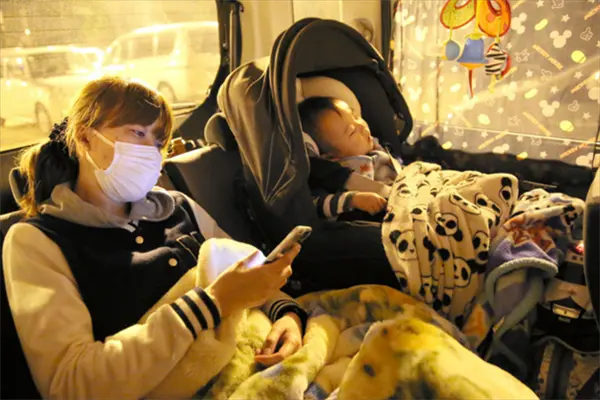Hitomi Kondo, her 1-year-old son, Ryusei, and other family members live in their car on the yard of Seizan Junior High School in Kumamoto on April 17. The family has spent three nights in the vehicle. (Taku Hosokawa).
After fleeing from one school to the next in search of safety, a 49-year-old quake evacuee spent a restless and chilly night outside in a schoolyard.
About 110,000 people are currently staying at evacuation centers in Kumamoto Prefecture. But with supplies running low and stress building from the continuing aftershocks, some residents are venturing out into their damaged communities and ending up sleeping in cars or yards.
The woman, who lived alone on the fourth floor of an apartment building in Kumamoto’s Chuo Ward, ran to a nearby elementary school after the magnitude-7.3 earthquake rocked the area early on April 16.
She noticed that the shaking had caused cracks in the school buildings, so she immediately moved to an adjacent junior high school. She was instructed to go to the second floor.
But she said she thought, “If another big earthquake occurred, it could become impossible to use the stairs, and I could not be able to escape outside.”
She slept outdoors, covered in a blanket.
A man in his 40s, who is also from Chuo Ward, and his two children evacuated to a junior high school after the April 16 earthquake. But they were instructed to wait outside because the priority was on securing space for elderly people and families with infants.
He heard from a relative that Kumamoto prefectural government building had toilets and water, so he came to the building with the children. Many others have also gathered at the government building.
However, it is not designated as an evacuation center.
In the town of Mashiki, also in Kumamoto Prefecture, Chizuru Hayashida, 42, spent three nights with her husband and three children in their car after an April 14 earthquake registered a maximum 7 on the Japanese intensity scale.
“My (1-year-old) second daughter has a fever, but I have antifebrile for only one day,” the mother said. “I do not have medicine for colds, either.”
With food and water in short supply, Hayashida drove the car around the town on April 17 although the roads were severed in many locations, and finally found a convenience store.
She had to wait in line for three hours only for a few “onigiri” rice balls.
Her anxiety grew when she found no gasoline stations operating.
(THE ASAHI SHIMBUN)
 简体中文
简体中文

